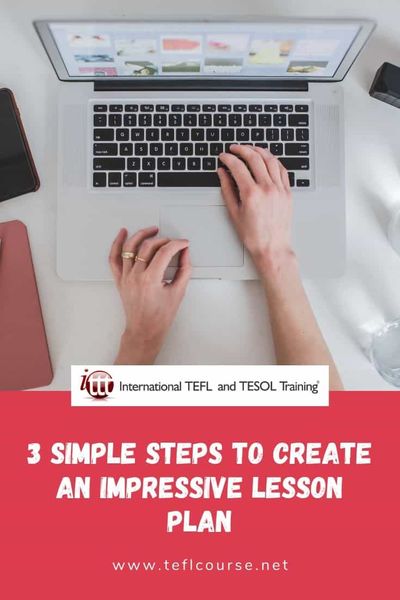3 Simple Steps to Create an Impressive Lesson Plan

Planning a lesson is an essential task of the teaching profession. Knowing how and when to plan a lesson can be beneficial for both teacher and students. There are various theories on this topic. The three main approaches are fully planned lesson, freestyle improvisation, and somewhere between these two extremes. As described by Jim Scrivener, planning is essentially a thinking skill. The teacher anticipates situations or problems and tries to come up with a structuring framework. This increases his/her options throughout the course.
Table of Contents
2. Consider The Type of Audience
Do you want to teach English abroad?
This post was written by our TEFL certification graduate Ahmad A. Please note that this blog post might not necessarily represent the beliefs or opinions of ITTT.
1. Choose a Method
In this essay, I intend to firstly, introduce a basic model of a lesson plan according to the Engage-Study-Activate (ESA) method. Secondly, I will list different target groups, and lastly, I will explain how to adjust the plan to the needs of these groups.
The Engage-Study-Activate method in lesson structuring was introduced by Jeremy Harmer. This method provides students with the necessary motivation for their learning journey, exposure to the language, and the opportunity to apply it in the classroom. The first phase of this approach is the Engage phase. This should be the warm-up phase for the students in order to get them thinking and speaking in English, and raising their interest by using materials and activities such as games, music, pictures, etc. The second phase is the Study phase. Here, the students focus on the language and its construction. The Study phase normally starts with elicitation, followed by presenting the subject of that very lesson, and the teacher concludes with a worksheet exercise. The third and final phase is the Activate phase. In this phase, students can freely use what they have learned focusing on fluency and with the help of activities such as role-plays, communication games, debates, etc.

Also Read: How do I choose a TEFL course?
2. Consider The Type of Audience
Planning a lesson can be challenging depending on what kind of student groups the instructor intends to teach. The four main groups are adult learners, individual learners, children, and business clients. For instance, preparing a lesson for an adult class in a language school will most likely be based on the textbook and the material provided by this specific school. On the other hand, planning an individual lesson will depend completely on the teacher to prepare all of the materials and the activities, bearing in mind to adjust them to the student's need. Preparing extra activities is a good option since students in 1 on 1 lesson go over the material much faster. Anticipating a lesson for children might be the most challenging one as they have short attention spans and get bored fast if they have to sit and listen for longer activities. Therefore, the teacher should plan ahead for all topics that s/he intends to teach and have entertaining and playful shorter learning activities ready in advance to cover the entire lesson. When teaching Business English or English for Specific Purposes (ESP), the instructor should prepare his/her lesson based on the client's needs. In this group, the learner or the client might be an individual student, an in-company group, or an in-school group. Based on the kind of group a teacher is assigned for s/he has to adjust the lesson planning and the preparation activities.

Also Read: Should I take a TEFL course online or in a classroom?
3. Approach to Writing
When writing a lesson plan the teacher should keep it simple and short. He/she should also calculate and note the approximate time for each activity that will take place in the lesson. Most importantly, he/she must stay flexible and open to adopt any changes. The learner objectives and personal aims should be clear and written down alongside language points, teaching aids, anticipated problems, procedure, phases of the lesson, class level, number of students, date/time, and teacher's and observer's names.
Do you want to teach English abroad?
In conclusion, planning a lesson has many benefits for the teacher and the students alike, such as avoiding to waste time during the class to think about what to teach when. It provides students with a clear topic that allows them to have a better learning experience by better understanding of what they have learned. Therefore, teachers should have a clear teaching method planned that suits each group of learners and have it written down and documented in a clear, yet simple and flexible way.
Apply now & get certified to teach english abroad!
Speak with an ITTT advisor today to put together your personal plan for teaching English abroad.
Send us an email or call us toll-free at 1-800-490-0531 to speak with an ITTT advisor today.
Related Articles:
- The 5 Best Ways To Build Rapport With Your TEFL Students
- The Benefits of Having Good Rapport with Students
- The 10 Best Destinations for Teaching English Abroad in 2018
- 5 Great Places to Teach English Abroad Without a Degree
- The Top 5 TEFL Destinations For Adrenaline Junkies and Adventure Seekers
- Online or In-Class - Which TEFL Course Should You Take?
Listen to this blog post:




